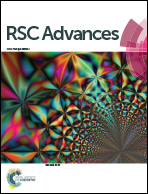Smart cleaning cotton fabrics cross-linked with thermo-responsive and flexible poly(2-(2-methoxyethoxy)ethoxyethyl methacrylate-co-ethylene glycol methacrylate)
Abstract
The smart cleaning ability of cotton fabrics is realized by cross-linking thermo-responsive random copolymer to the cotton. Poly(2-(2-methoxyethoxy)ethoxyethyl methacrylate-co-ethylene glycol methacrylate), denoted as P(MEO2MA-co-EGMA), is synthesized from 2-(2-methoxyethoxy)ethoxyethyl methacrylate (MEO2MA) and ethylene glycol methacrylate (EGMA) with a molar ratio of 17 : 3. Its dilute aqueous solution (1 mg mL−1) presents a lower critical solution temperature (LCST) of 38 °C. Furthering increase the solution concentration, the LCST shifts towards lower temperature. By applying citric acid as a cross-linker, P(MEO2MA-co-EGMA) is successfully immobilized onto cotton fabrics. The obtained cotton fabrics also possess thermo-responsive property with a LCST at 37 °C. The smart cleaning ability is confirmed by single fiber cleaning experiments using a confocal microscope. It is observed that the cleaning ability of the cotton with cross-linked P(MEO2MA-co-EGMA) can be prominently enhanced at low temperature (below LCST). In addition, due to the low glass transition temperature of P(MEO2MA-co-EGMA) (−26 °C), the polymer is in a gel state at room temperature and will not negatively impact fabric softness. P(MEO2MA-co-EGMA) is a promising candidate for preparing textiles with smart cleaning ability and great fabric hand.


 Please wait while we load your content...
Please wait while we load your content...